Storage of boats in winter
Before going ashore, the vessel should be completely disarmed: remove the mast and rigging, windscreen, distinctive lights and plafonds, upholstered seats, payoles; release all lockers, cabinets, boxes, tanks; transfer oars, batteries, canisters, covers, ropes, anchors, etc. to the shore.
It is desirable that the place for winter parking on the shore should be at least 1 meter above the water level in high water. It is better to place a wooden vessel for wintering with its nose to the south — southwest, so that in spring the sun warms both sides at the same time. Otherwise, one of the sides will certainly crack and crack. The vessel, depending on its size and contours, should be installed on special linings, shaped keel blocks or sledges.
The simplest sledge for storing a boat on the shore
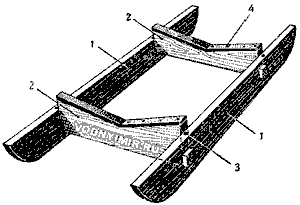 1 — longitudinal beams-runners; 2 — crossbars-keel blocks; 3 — bolts; 4 — soft upholstery |
It is very easy to make a sledge for light boats. The bow and stern keel blocks, sheathed on top with felt or other soft material, are attached to the two longitudinal beams-runners with through bolts. On such a sledge it will be convenient to move the vessel, putting rollers under the runners. Finally, a light vessel can be stored on shore using the same sled during summer navigation.
If the vessel will be stored outdoors, it is better to put the sled on trestles or racks — four pillars with crossbars dug into the ground. The height of the racks above the ground should be at least half a meter, so that ventilation is good, and in the spring it was more convenient to make repairs.
Sledges for heavy boats with a large keel and keel yachts have a more complex design. In two longitudinal beams (300x200), the same powerful crossbars are embedded with a lock, on which the keel of the vessel will fall. At the place of sealing the crossbars on the hinge bolts, folding stops are fixed, the angle of inclination of which is set by the rasp. A felt cushion is stuffed on the cut of the stop to protect the side of the vessel from scratches and dents.
Sleigh with folding stops for keeled vessels
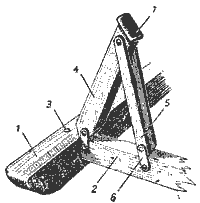 1 — longitudinal beams-runners, 2 — crossbars (keel supports), 3 — bolt, 4 — folding stops, 5 — bracing, 6 — steel strip-lining, 7 — soft upholstery. |
Such sleds can be stored disassembled in summer. It is convenient to paint the sides in them, since you can move the stops separately. Sections of longitudinal and transverse bars, stops and braces are selected depending on the weight of the vessel, and the length of the sled and the number of stops so that the distance between the stops does not exceed 1.5 m.
If there is no time to make a sledge, the vessel can be loosened with supports, placing under the keel bars-linings with a cross section of 250x250. It is best to rest the upper ends of the supports against the rest beam, then they will not slip off. If you have to rest them on the cheekbone, it is necessary to lay wedges. The lower end of the supports is securely fastened with a peg driven into the ground. In order not to waste time searching for suitable beams, stakes and logs every autumn (preferably with a diameter of about 100 mm), it makes sense to make permanent sliding support posts from metal pipes with a diameter of 40-80 mm, preferably not too heavy! To be able to change the length of the racks, it is necessary to make them from two parts — telescopic, i.e. inserted into one another, or connected on couplings — and drill a number of holes in height for fixing with a cotter pin, wire, etc.
Yacht in winter parking
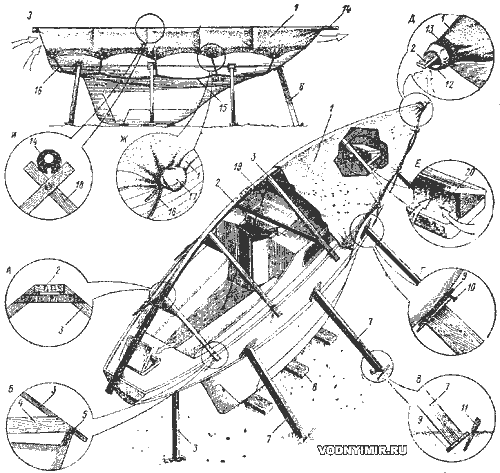 A — the upper node of the frame under the cover; B — fastening of the rafters to the bulwarks; C — the lower end of the support; D — the upper end of the support; D — a device for ventilation at the ends of the cover; E — an open nozzle; G — a reliable option for fixing the seznevki without grommets; Z — option with storing the mast on the deck of the yacht; And — laying the mast on the supports (folding sector). 1 — cover; 2 — frame ridge; 3 — rafters; 4 — bracing: 5 — knits; 6 — support under overhangs; 7 — side supports; 8 — lining under the keel; 9 — gasket; 10 — nail that prevents the wedge from popping out; 11 — wedge; 12 — an old bucket without a bottom or a rolled sheet of plywood; 13 — strapping with a thin line; 14 — mast; 15 — rail around the hull; 16 — seznevka; 17 — stone; 18 — sector; 19 — guy ropes; 20 — gaskets under the hatch cover. |
A pin with a diameter of 12-20 mm is welded into the upper part of the metal rack. Then a cap-tip is made of wood, which is put on the end of the pipe; it should be able to rotate on the pin at a certain angle for a tight fit to the shaped surface of the side. If the sides are varnished, the tip must be upholstered with a soft cloth.
Tubular support with wooden headrest
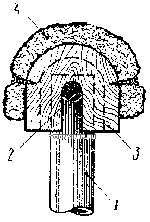 1 — pipe, 2 — transverse pin, 3 — wooden headrest, 4 — upholstered upholstery. |
When installing supports and linings, it is necessary to take into account the strength of the vessel's hull and its individual external parts, as well as the location of the main cargo in it. For example, you can not put a bar under the steering spur — over the winter the boat will sink, the steering wheel will jam in the podpyatnik. Supports in all cases should be placed on a set, preferably against bulkheads or reinforced frames. With thin sheathing under the ends of any supports adjacent to the body, it is necessary to lay clippings of boards that distribute pressure over a certain large area. It is desirable to lay the bars under the keel under the locations of the largest loads — heavy engine, ballast, etc. All linings and supports must be loaded evenly, otherwise the hull may bend, there will be water leakage in the deck and skin.
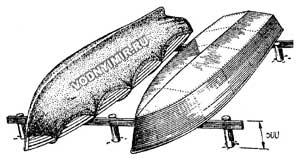 Light boats should be stacked bottom up; sometimes it makes sense to make racks for many boats at once to stack them in two or three tiers.
Light boats should be stacked bottom up; sometimes it makes sense to make racks for many boats at once to stack them in two or three tiers.
The vessel pulled out for winter storage must be washed immediately, starting with the underwater part, before it has time to dry out. Mucus, algae and shells are removed with a stiff brush, a strong layer of shells is removed with fine sand. The waterline area has to be wiped with gasoline or kerosene to remove traces of fuel oil and oil from the paint. It is usually enough to wash the freeboard with a soap solution (one piece of household soap and 400 g of soda per 10 liters of water) using brushes. The washed side should be wiped dry with a rag, immediately stripping the lagging paint from the skin and cleaning the grooves from the squeezed caulk.
After carefully removing all the garbage and dirt, clean the scuppers, and then wash the ship inside, mainly the hold — the space under the slates (having previously unscrewed the drain plug), storage areas of various stocks, galley, latrine, etc. You need to wash with brushes and soap and soda solution until you no longer feel smells of gasoline, oil, rot.
Tanks and cisterns, after water and fuel residues have been drained from them, must be cleaned of sludge and slime.
Before covering the vessel with a cover, ensure good ventilation of the interior and compartments — remove all the polices, open lockers and lockers, hatches, doors, blinds, etc. If possible, it is better to leave the entrance doors and hatch covers not completely closed by placing wedges-gaskets. Sealing rubber on hatches, plugs, etc. should be smeared with a thick solution of chalk. Suspensions, latches and all other metal parts remaining on the ship for the winter must be cleaned of rust and dirt and lubricated with grease or other thick grease. Chrome and nickel-plated parts are covered with an aerosol liquid or a thin layer of the same grease. Threaded parts, such as turnbuckles, bolts, plugs, etc., must be unscrewed, cleaned of rust, lubricated with grease with graphite powder and reassembled.
Brief tips on preparing for the winter of a stationary engine can be found in No. 21 «Boats and yachts». Here we just note that it is necessary to drain the water from the engine cooling system, close the Kingston, muffle the exhaust pipe, tightly cover the engine compartment from moisture. The dehumidification pump must be disassembled, the moving parts washed in kerosene, wiped and oiled.
The vessel, prepared for winter storage, must be carefully inspected once again, determining the degree of wear of structures, so that some parts and blanks necessary for repair can be made in advance — even in winter.
After drying, we recommend cleaning the case from the lagging layers of paint, and the opened tree — proolifit. It is necessary to free the grooves from the protruding raw or rotten caulking.
The steel cladding must be cleaned with a metal brush from rust, duralumin — from oxide stains, which are easy to detect by the swollen paint. The exposed metal should be immediately covered with a layer of protective soil, and in the southern regions it is best, taking advantage of dry weather, to prime the entire body.
Now we need to shelter the ship from snow and rain, and in the spring — from the sun. The shelter should be strong enough to withstand the gusts of winter wind and heavy snow cap. At the same time, it is desirable that good ventilation of the hull and superstructures is provided.
The best way to meet all the requirements is a low canopy over the boat or, if the boats are small, over a whole group of them. If it is impossible to build a canopy with a hard roof on poles, it is made on the ship itself. The frame can be assembled from light rafters resting on the sides of the boat, and a longitudinal ridge board passing through these rafters. The free lower ends of the rafters are usually released outwards so that the canopy covers the sides and water flows from it to the ground. In order to avoid a longitudinal shift of the frame, the rafters in the middle part of the vessel must be loosened with stretch marks.
A canvas cover is stretched over the frame, or boards are sewn on and roofing material (roofing) is laid, for reliability, pressing the edges of the strips with slats. The canvas cover is tightly wrapped with strong ends, passing them under the keel of the vessel or tying them to a rail that wraps around the entire hull under the cheekbone. If the eyelets in the case are unreliable, it is better to wrap small stones in canvas and tie them with a line with a knotted knot.
To improve ventilation, it is useful to attach old buckets with a broken bottom in the bow and stern; in all cases, it is necessary to leave an air inlet in the cover. And if you arrange a valve from one of the sides opposite the entrance to the cabin, it will be very convenient in the spring, when you need to get into the ship to prepare for repairs, etc.
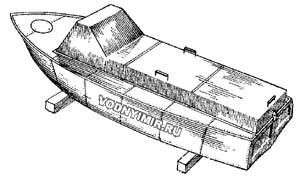 For small boats, such as the Kazanka, they often make permanent rigid covers made of roofing iron or duralumin, covering the entire cockpit and windshield. Of course, such a case can be locked. A wooden boat, even if it is upside down, it is better to cover it with a canvas cover from above.
For small boats, such as the Kazanka, they often make permanent rigid covers made of roofing iron or duralumin, covering the entire cockpit and windshield. Of course, such a case can be locked. A wooden boat, even if it is upside down, it is better to cover it with a canvas cover from above.
Some tips for storing equipment and equipment removed from the ship.
The anchor chain is most often placed under the ship on a specially made stand or suspended on a trestle so that it does not touch the ground and is reliably covered from precipitation.
Batteries should be stored in a dry room at a positive temperature, alkaline batteries should be discharged, and acid batteries, on the contrary, fully charged (otherwise they are sulfated).
All cables and rigging parts are dried, assembled into bays and hung on hooks in the locker. The mast is stored in a dry room on specially made racks or suspended from the rafters. In order for the mast not to bend, the number of support points (suspensions) should be as large as possible. You can also lay the mast on the deck of the yacht in the form of a longitudinal base — the ridge of the cover frame. The sails should be properly ventilated in the sun before laying in the locker.
In the section «Motorboats, boats, yachts — miscellaneous, reviews, tips»
Share this page in the social. networks or bookmark:
